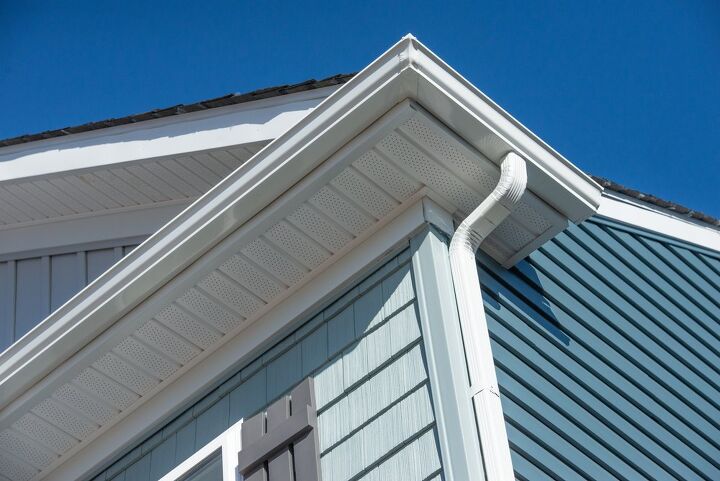5-Inch Gutters Vs. 6-Inch Gutters: Which One Is Better?

Many homeowners are likely unaware that different-sized gutters exist, and we’d venture to suggest that even more homeowners are unaware of the size of the gutters on their property! It’s a crucial detail to understand because it affects the performance of your gutter system significantly.
If your roof is steep, or if you live in an area with frequent rainfall you will want a 6-inch gutter for your home. But usually, 5-inch gutters are the most commonly used ones. The 6-inch gutter helps with about 50% more rainfall than the 5-inch and is sufficient for steeper roofs.
We’ll go through the differences between the two most typical gutter sizes that homeowners are presented with: 5′′ and 6′′ gutters. We’ll also give you some pointers on what to think about when changing your gutters due to age or damage, or if you want to put new gutters on a home or structure that’s being built.
If you’re starting a new gutter installation project, do it right the first time, and this guide will help you feel secure in your choice.
Do You Need Roofing, Siding, or Gutter Installers?
Get free, zero-commitment quotes from pro contractors near you.

What Is Your Gutter Systems Job?
This may seem self-evident… But, for individuals who aren’t familiar with these systems and are new homeowners, we’ll go over it.
Any gutter system’s goal is to direct all of the rainwater from your roof into the proper drainage system, preventing flooding of your foundation or property. If the job of the gutter system is to transfer water, then the larger the gutter, the more water it will move!
Which Is Better? 5-inch vs 6-inch Gutters
A professional gutter contractor can look at (and measure) your roofline to obtain a decent estimate of how square your roof is (this is how roofers measure a roof’s surface area).
With this information, we can estimate how much water will need to be routed away following a storm. We can see the average rainfall in our location using other data, so we can design and build gutter systems that won’t fail.
When it comes to choosing the correct size gutter, there are numerous factors to consider, but a 5′′ gutter is usually sufficient for most residential applications. A 6′′ gutter can be a better alternative if you have a very large, steep pitch roof and live in a location where rain falls more frequently than typical.
If you have a bigger roof area and want the maximum performance from your gutters, 6′′ gutters with larger 3′′x 4′′ leaders (downspouts) can manage roughly 50% more water than a typical 5′′ gutter. Even during the heaviest of wind-driven downpours, this reduces the likelihood of your gutter overflowing.
Calculating The Correct Gutter Size
Calculating the proper sizing for your gutters involves quite a bit of math and physics. The first step is to calculate the entire square footage of your roof’s drainage area.
You just need to do two calculations (length x breadth), one for each side of the roof, for the most basic gabled-ended roof with two sides and no dormers or further levels (or slope).
When a roof has dormers, hip roofs, or areas where the roof may connect with another element of the building, the calculation gets much more complicated! Add the surface areas of all the “shapes” to get the total square footage.
You’ll need to change your calculation for the following two elements once you or your gutter contractor know the total square footage of drainage necessary for each gutter:
The Roof Pitch
The burden on your gutter system grows as the pitch of your roof gets steeper because it can capture and collect a lot more windblown rain. A level and a tape measure are typically used to determine roof pitch.
If you don’t feel comfortable climbing up on your roof to do this, contact a professional gutter contractor like LIK Gutters, who can swiftly take these measurements and answer any concerns you might have concerning gutter installation.
Maximum Rainfall In Your Area
Most residents are unaware that the United States Weather Bureau has records of the highest rainfall in 5 minutes, measured in inches per hour, for several places across the country, including New York and New Jersey.
This crucial piece of information allows us to make the best gutter sizing decision possible, ensuring that you aren’t overcharged for something you don’t require. The wider and steeper your roof is, and the higher the maximum rainfall in your area is, the bigger your gutter will need to be!
Don’t Forget The Size Of Your Downspout
Before you get caught up in sales pitches about which gutter size is best for your home, double-check that your downspouts are properly sized. If you’re having new downspouts built along with your gutters, be sure the gutter contractor calculates their size based on the maximum amount of rainfall your area gets.
Gutters’ sole purpose is to direct water away from your roof and into downspouts. Downspouts direct water into drain tiles and away from your house and foundation, thus the more water they can handle, the better.
Can You Install Gutters By Yourself?
Professionals usually install gutters, but there’s no reason you can’t do it yourself. All of the materials and accessories may be found in home improvement stores, lumberyards, and roofing supply companies.
If you’re going to repair your gutters and downspouts, you might as well enhance your rainwater system’s overall appearance and performance.
Installing Gutters Yourself Can Help You Save Money
When professionally built, gutters and downspouts, both critical components of most homes, cost roughly $3,000 for the average-sized U.S. home of slightly under 2,400 square feet.
With that said, if you’re ready to perform the task yourself and install your own gutters, you can save a lot of money.
How Much Do Gutters Cost?
Gutter installation costs from $592 to $1,575 per 200 feet, or an average of $1,083. Vinyl gutters range in price from $3 to $5 per linear foot.
Aluminum ranges in price from $6 to $12, steel from $9 to $20, and copper from $25 to $40 or more. Compare quotes from local gutter installers to find the best deal on new gutters.
The natural deterioration of gutters is one of the risks of owning a home. Well-maintained systems and of excellent quality can endure up to 20 years.
If they begin to sag or slide away from your home, it’s time to think about maintenance or replacing them entirely. While the process may appear onerous, a home with poor drainage is far more dangerous—and pricey.
Gutter Installation Cost
A skilled contractor’s estimate for installing 125 to 200 feet of gutters on a property ranges from $1050 to $2400, depending on material and installation rates.
In addition to labor, this estimate includes materials. Installation should cost roughly $10 per linear foot; however, pricing will vary depending on the cost of living in your location. The pitch of your roof has an impact on the cost, and a steeper incline will cost more.
Based on the nature and scope of the job, the following is an estimate of the average cost of gutter installation (materials not included).
Do You Need Roofing, Siding, or Gutter Installers?
Get free, zero-commitment quotes from pro contractors near you.

Related Questions
What is the standard gutter downspout size?
Gutter downspouts range in size from 3 to 6 inches in diameter. The bigger a gutter downspout is, the faster it can drain water.An overly large gutter downspout, on the other hand, can be ugly. Although rectangular downspouts are the most common, they can also be round or square.
Should I get 5-inch or 6-inch gutters?
6-inch gutters can hold nearly half as much water as 5-inch gutters. For better water management, they have larger 3″x4″ downspouts installed.Because they can accommodate more water flow and have a larger outlet, 6-inch gutters are less prone to become clogged. Otherwise, 6″ gutters are the way to go.
What size are commercial downspouts?
The bigger gutter size will give commercial applications the extra durability they require. The size of the downspout is also a consideration; 5-inch gutters typically utilize 2-by-3-inch downspouts, whereas 6-inch gutters use 3-by-4-inch downspouts.
Related Guide

Heather is a passionate writer who loves anything DIY. Growing up, she learned everything from home repairs to design, and wants to share her tips with you. When she's not writing, she's usually hiking or searching for her next DIY project.
More by Heather Robbins



























